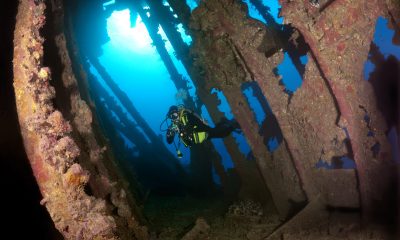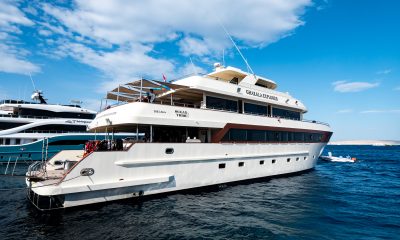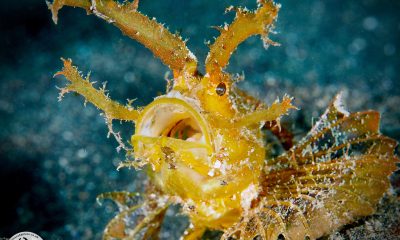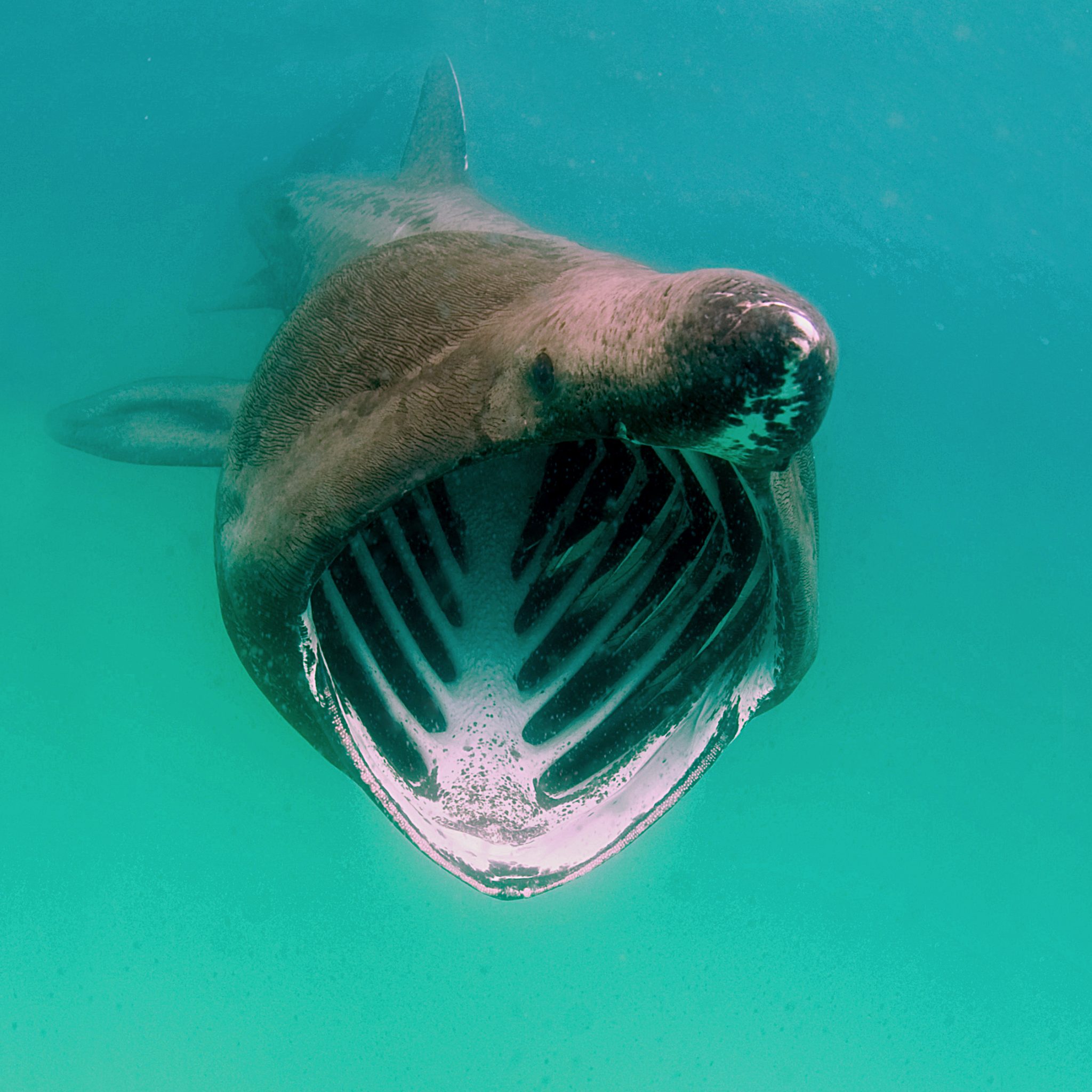News
Can you Climb a Boat Ladder in Sidemount?

by John Bentley
Sidemount is mainstream as a gear configuration and it works well for lots of people. While it originated in cave sites, it’s a common sight on dive boats, local quarries, and shore sites in present day. For good reasons, some people are hesitant about sidemount boat diving. This is due to two main reasons, both involving the wide surface profile of sidemount:
- Walking down boat aisles is hard in wide-mount.
- Climbing up small boat ladders is hard in wide-mount.
While in a horizontal profile underwater, sidemount feels very balanced and streamlined. Stand on the surface though and you’re wider than your pals in backmount. How do you mitigate those problems and enjoy a boat dive in your preferred gear configuration.
General Tips
- Leashes
Not all sidemount instructors utilize leashes in their courses, but for boat dives they’re almost required. Leashes, chokers, necklaces; there are a number of names for the clips that offer a hard connection, often paracord, that secures the cylinder to the harness. This is typically in addition to the bungee that snugs your cylinder into place. - Bungees
These elastic devices help snug the cylinders closer to the diver’s body when underwater. Typically, the diver does not want these attached on the surface as it puts stress on the bungee system, decreasing its life. - S-Drills
Often times with sidemount, you enter the water without everything hooked up. Routing on the surface is pretty difficult so a popular method is to have 1 cylinder (often the left) all hooked up (except the bungee) when entering the water. That way your BC can be inflated and there is a 2ndstage off which to breathe. After entering the water, you descend a few feet, attach the bungees, route any hoses, and perform an s-drill. When well-practiced this can be done on the descent and done by 15ft (6m).
Getting off the Boat
- Single top clip method
This popular method still makes you wider than backmount, but is easier to manage. Attach the left cylinder in full – top clip, bottom clip, LPI, and 2nd Pressurize the system and test functioning of the breathing and inflation. Then top clip only the right side. Without the bottom clip, the cylinder can hang freely in front of you. Then you’ll only be as wide as one cylinder. - Drop cylinder method
For boats that tie into the dive site in calm waters you can have the mate hand cylinder(s) or place cylinders on a drop line. This way you can enter the water with as many or few cylinders as you’d like. For people that dive sidemount for medical considerations, this may be the only realistic option. - Get there early method
This is the least realistic of the methods and involves the right kind of boat. Get there as early as possible and grab the furthest stern seat to hook up and fall in once it’s time to dive. While especially convenient on drift dive boats with no transom, it isn’t the best method.
Getting on the Boat
Boat ladders are scary, there’s no way around that. They’re scary because people don’t know how to handle them to start, so let’s start with general tips.
- Approach the ladder slowly and thinking
Your goal is not to get up the ladder; it is to get on the ladder. That’s the difficult part. Slowly approach the ladder, listen to the crew, and be cognizant of the boat’s movements. - Plant those feet, don’t lock your arms, and get all your weight on the ladder.
Treat the ladder like a leg press machine. After your feet are on the bottom rungs, straighten your legs and the ladder is no longer your enemy; it’s your spot to hang out. - Go up rung by rung and plan your hand holds. Look ahead to where your hand will be for support.
- Allow the DM to help out.
You’re carrying a lot of extra weight and are probably unstable. It’s ok to get help. Just make sure to tip appropriately.
With the basics down, let’s look at sidemount-specific steps. Decide on your plan of action beforegetting in the water and visualize it for the most success. Cleaning your cylinder on the safety stop is a common prep method that pays off when getting back on boats. Simply remove the bungee, bottom clip, and temporarily stow the regulator on one cylinder. That leaves 1 cylinder attached only by the top clip, making it fast to do any of the below methods.
- Hand up method
This is one of the more popular methods. Just hand one cylinder up to the DM after approaching the ladder. For fins-off ladders, it’s important to not remove your fins until you’re ready to climb the ladder. So hand the cylinder up, go back to the tag line, remove your fins, then approach the ladder for exit - Muscle it up
This option isn’t realistic for everyone, and exertion after a dive isn’t a good idea. With that said, maybe you’re diving steel 50s, AL 80s, or AL 40s. Lighter cylinders like that can go up the ladder pretty easily, especially employing the single top clip method on one side. Larger cylinders will probably just result in a clunky climb and wobbly walk. - Drop line
If you entered with a drop line it’s pretty easy to exit with one! Just clip off on your swim to the stern of the boat.
So there it is. With a few quick tips, a decision, visualization, and a little practice, you can take your preferred gear configuration to the open water off a boat. The best way to learn this is to take a course with a TDI instructor. Find one here: https://www.tdisdi.com/search/?area=instructors
To find out more about International Training, visit www.tdisdi.com.

Blogs
Northern Red Sea Reefs and Wrecks Trip Report, Part 2: Wall to Wall Wrecks
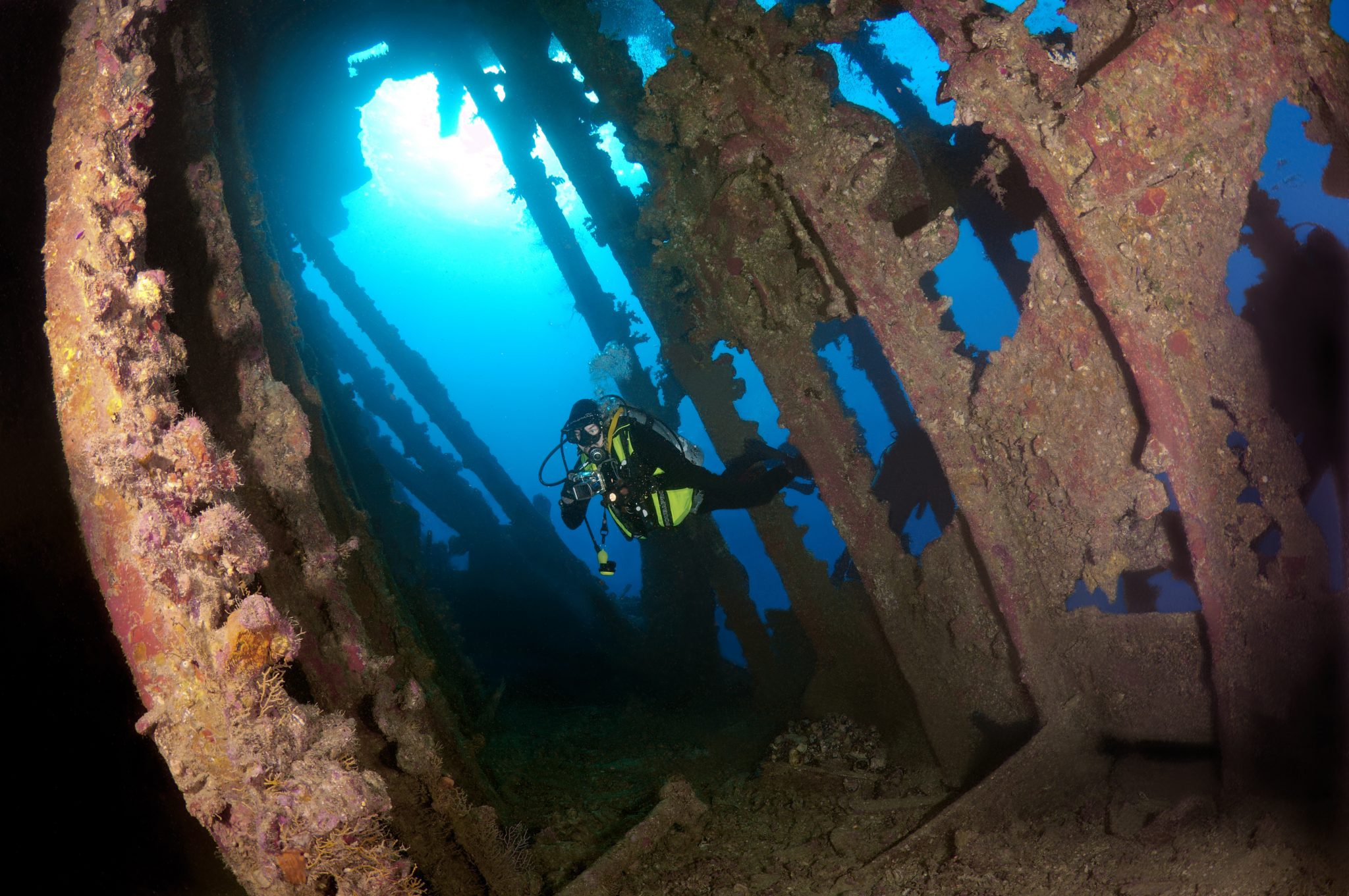
Jake Davies boards Ghazala Explorer for an unforgettable Red Sea diving experience…
The second day’s diving was a day full of wreck diving at Abu Nuhas, which included the Chrisoula K, Carnatic, and Ghiannis D. The first dive of the day was onto the Chrisoula K, also known as the wreck of tiles. The 98m vessel remains largely intact where she was loaded with tiles which can be seen throughout the hold. The stern sits at 26m and the bow just below the surface. One of the highlights of the wreck is heading inside and seeing the workroom where the machinery used for cutting the tiles are perfectly intact. The bow provided some relaxing scenery as the bright sunlight highlighted the colours of the soft coral reef and the many reef fish.
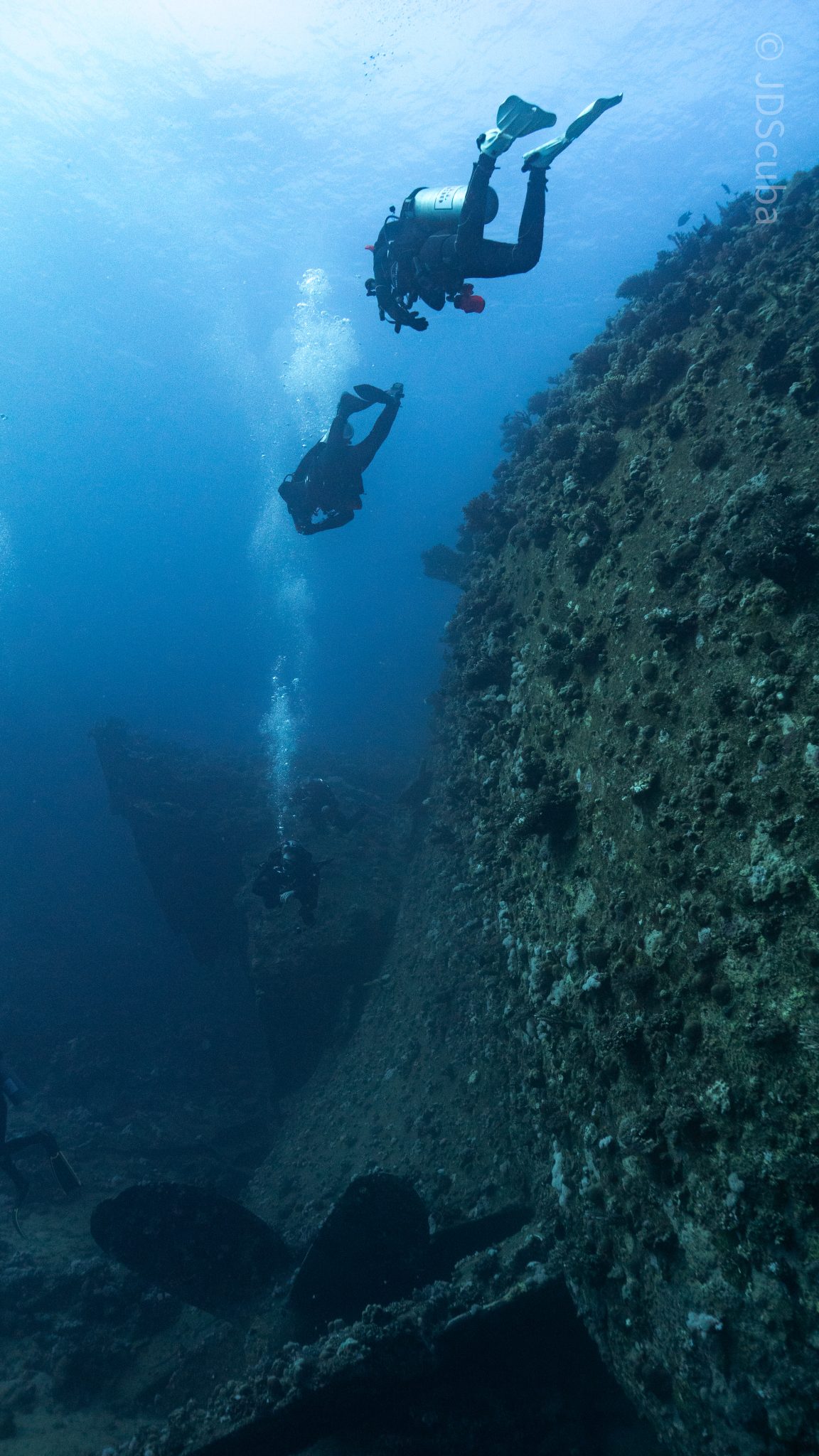
Following breakfast, we then headed to the next wreck, which was the Carnatic. The Carnatic is an 89.9m sail steamer vessel that was built in Britain back in 1862. She ran aground on the reef back in 1869 and remains at 27m. At the time, she was carrying a range of items, including 40,000 sterling in gold. An impressive wreck where much of the superstructure remains, and the two large masts lay on the seafloor. The wooden ribs of the hull provide structures for lots of soft corals, and into the stern section, the light beams through, bouncing off the large shoals of glass fish that can be found using the structure as shelter from the larger predators that are found outside of the wreck.
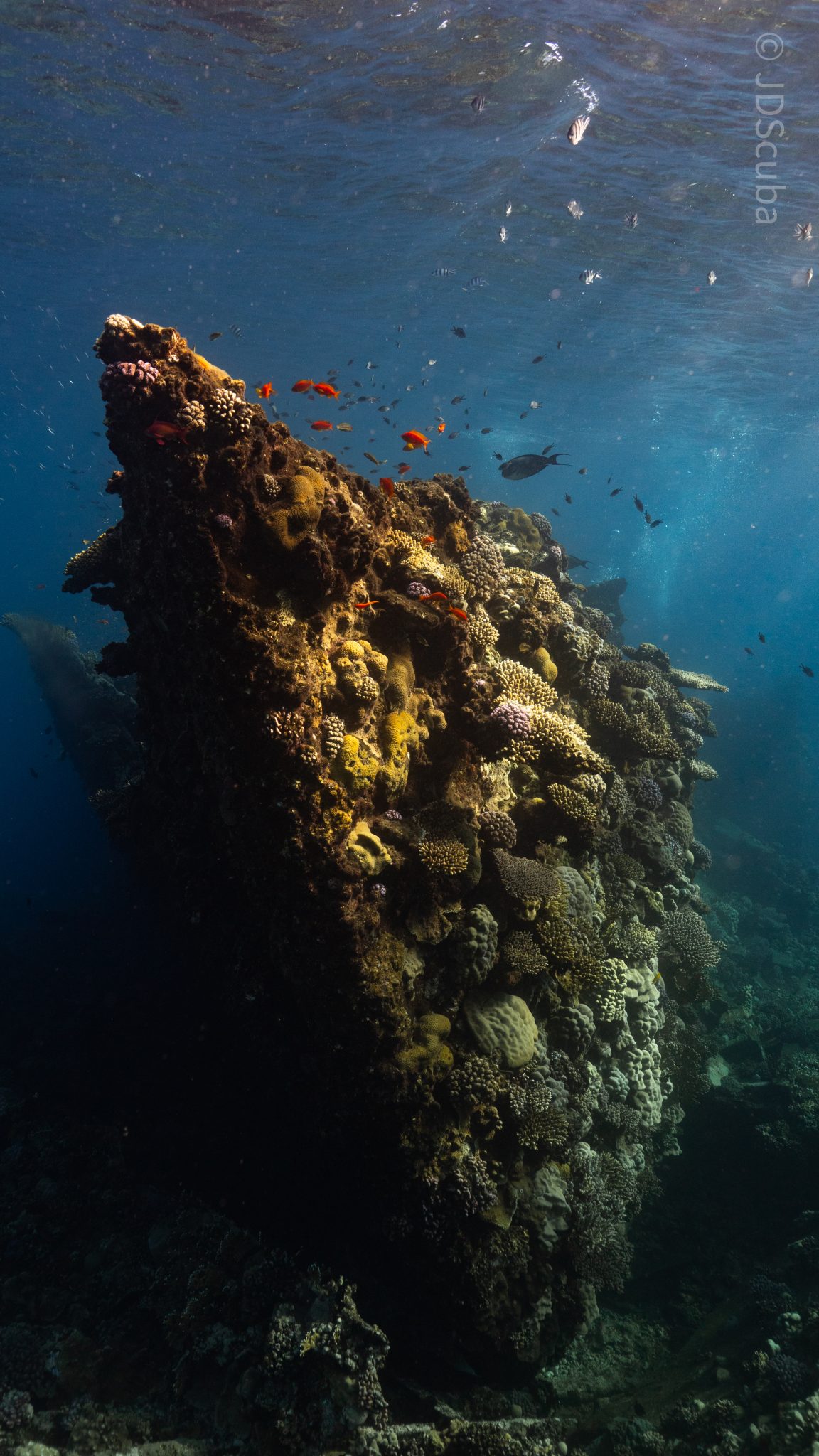
The final wreck at Abu Nuhas was the Ghiannis D, originally called ‘Shoyo Maru,’ which was 99.5m long and built in Japan back in 1969 before becoming a Greek-registered cargo ship in 1980. The ship then ran aground on the reef on April 19th, 1983, and now sits at the bottom at a depth of 27m. Heading down the line, the stern of the ship remains in good condition compared to the rest of the hull. The highlight of the wreck, though, is heading into the stern section and down the flights of stairs to enter the engine room, which remains in good condition and is definitely worth exploring. After exploring the interior section of the ship, we then headed over to see the rest of the superstructure, where it’s particularly interesting to see the large table corals that have grown at the bow relatively quickly considering the date the ship sank. After surfacing and enjoying some afternoon snacks, we made sure everything was strapped down and secured as we would be heading north and crossing the Gulf of Suez, where the winds were still creating plenty of chop.
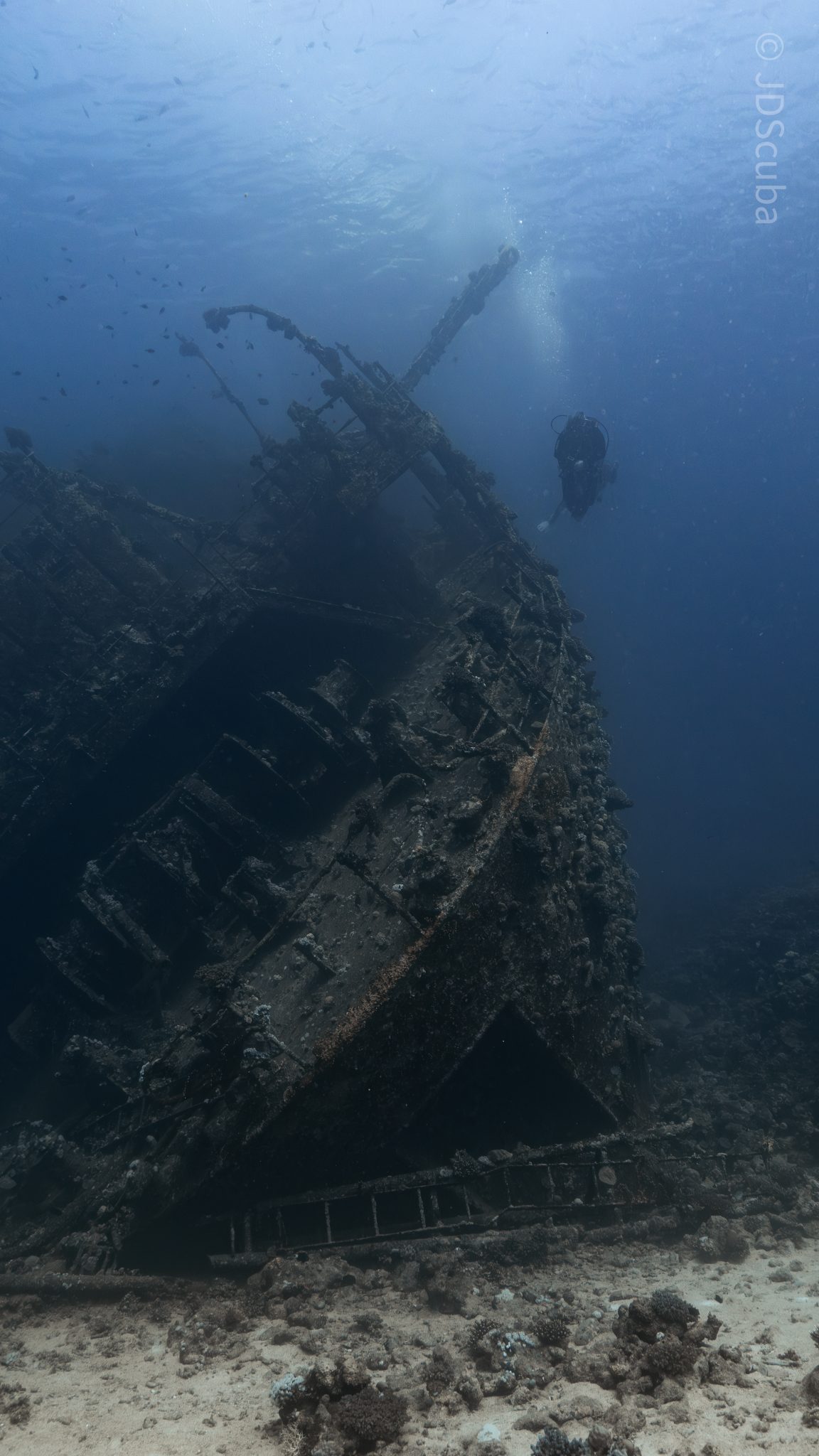
The next morning, it was a short hop to Ras Mohammed Nature Reserve for the next couple of days of diving. The 6am wake-up call came along with the briefing for the first site we would be diving, which was Shark & Yolanda. The low current conditions allowed us to start the dive at Anemone City, where we would drift along the steep, coral-filled wall. These dives involved drifts, as mooring in Ras Mohammed wasn’t allowed to protect the reefs. As a dive site, Shark & Yolanda is well-known and historically had a lot of sharks, but unfortunately not so many in recent years, especially not so early in the season. However, there was always a chance when looking out into the blue.
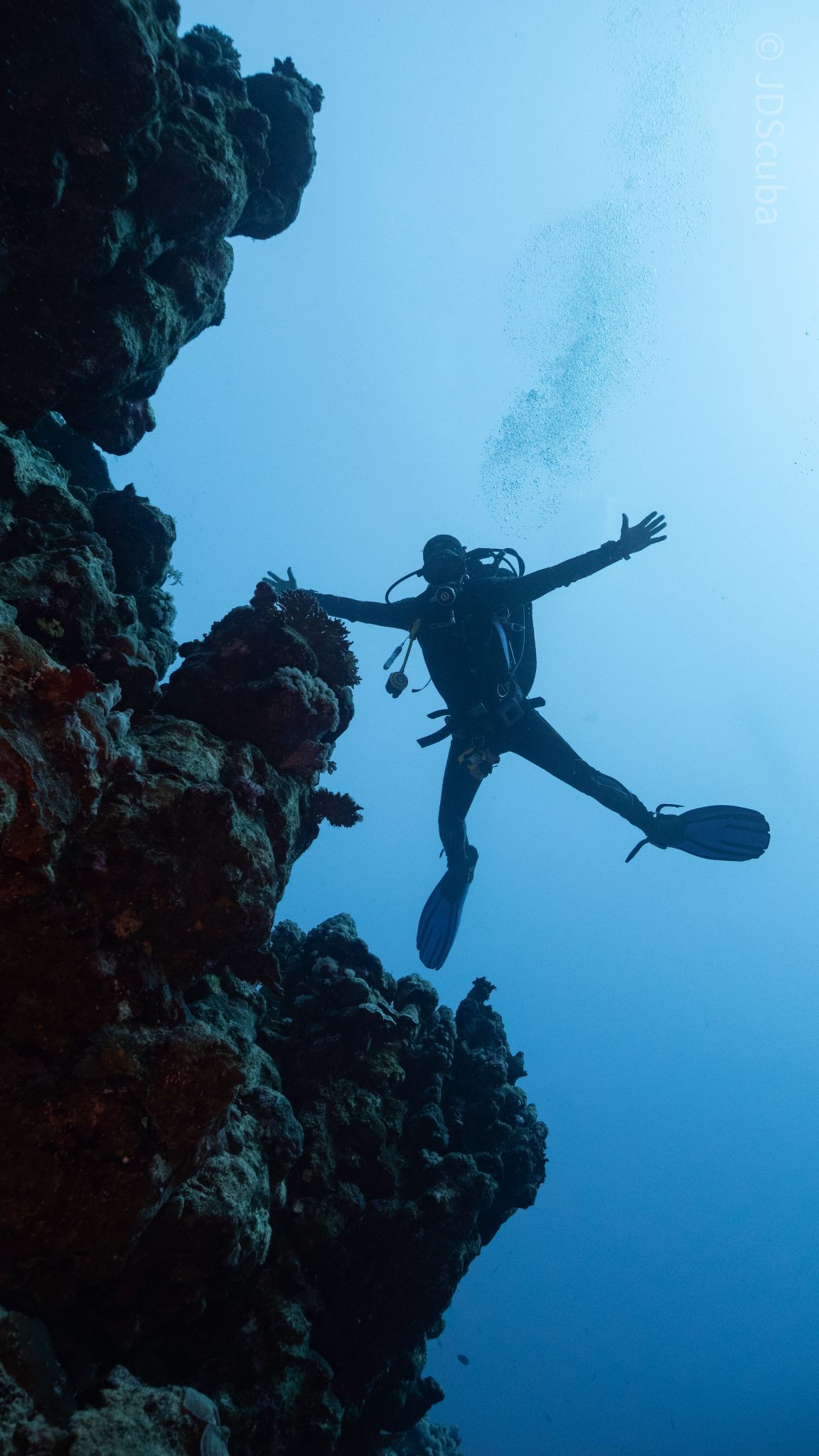
The gentle drift took us along the steep walls of the site, with plenty of anemone fish to be seen and a huge variety of corals. It wasn’t long into the dive before we were accompanied by a hawksbill turtle, who drifted with us between the two atolls before parting ways. Between the two reefs, the shallow patch with parts of coral heads surrounded by sand provided the chance to see a few blue-spotted stingrays that were mainly resting underneath the corals and are always a pleasure to see. With this being the morning dive, the early sunlight lit up the walls, providing tranquil moments. Looking out into the blue, there was very little to be seen, but a small shoal of batfish shimmering underneath the sunlight was a moment to capture as we watched them swim by as they watched us.
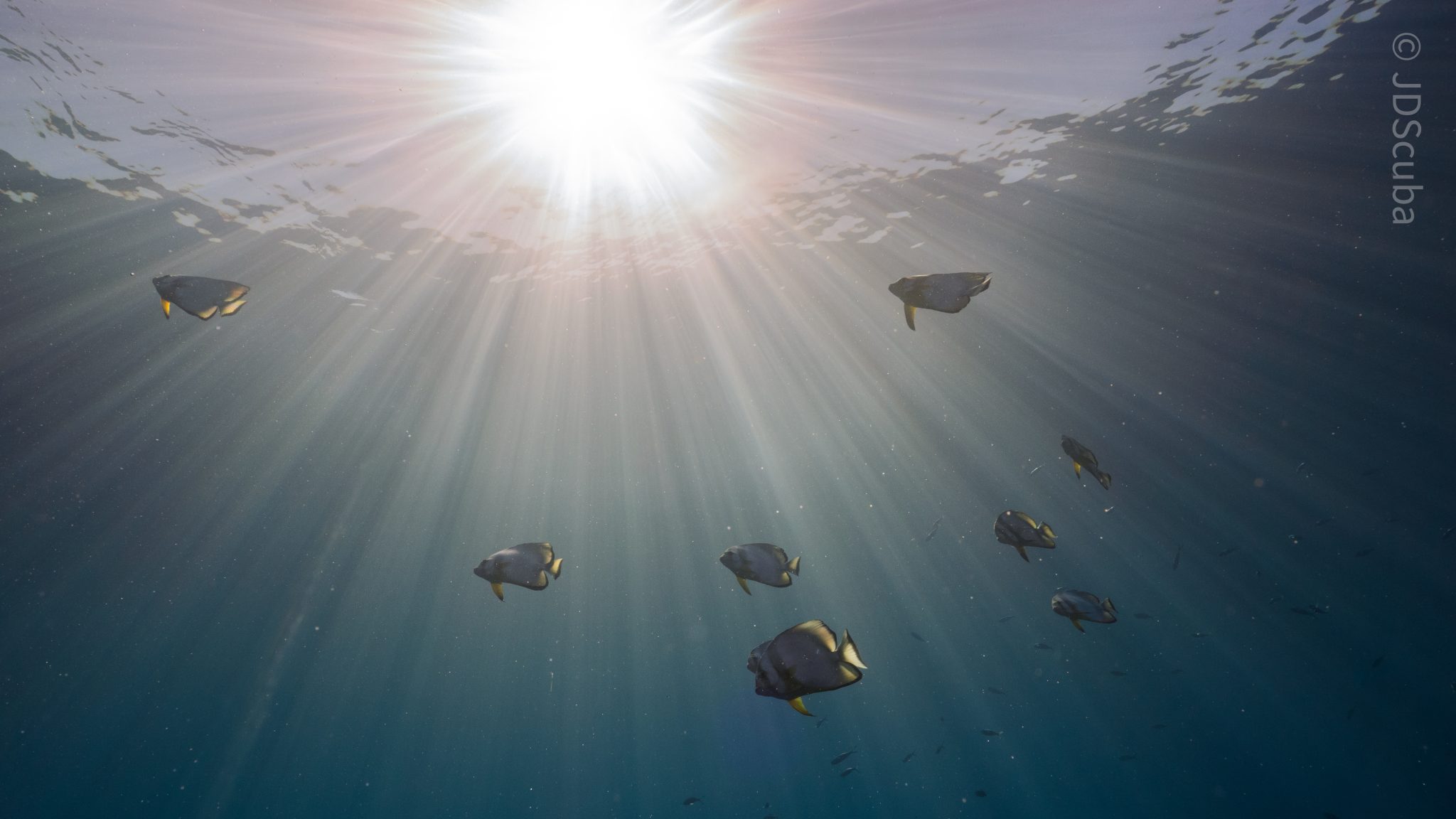
Towards the end of the dive, we stopped at the wreck of the Jolanda where the seafloor was scattered with toilets from the containers it was carrying. This provided a unique site to make a safety stop, which was also accompanied by a large barracuda slowly swimming by, along with a hawksbill turtle calmly swimming over the reef as the sun rays danced in the distance.
For the next dive, we headed north to the Strait of Tiran to explore the reefs situated between Tiran Island and Sharm El Sheik, which were named after the British divers who had found them. We started on Jackson before heading to Gordons Reef, where we also did the night dive. All the atolls at these sites provided stunning, bustling coral reefs close to the surface and steep walls to swim along, which always provided the opportunity to keep an eye out for some of the larger species that can be seen in the blue. Midwater around Jackson Reef was filled with red-toothed triggerfish and shoals of banner fish, which at times were so dense that you couldn’t see into the blue. Moments went by peacefully as we enjoyed the slow drift above the reef, watching these shoals swim around under the mid-afternoon sun.
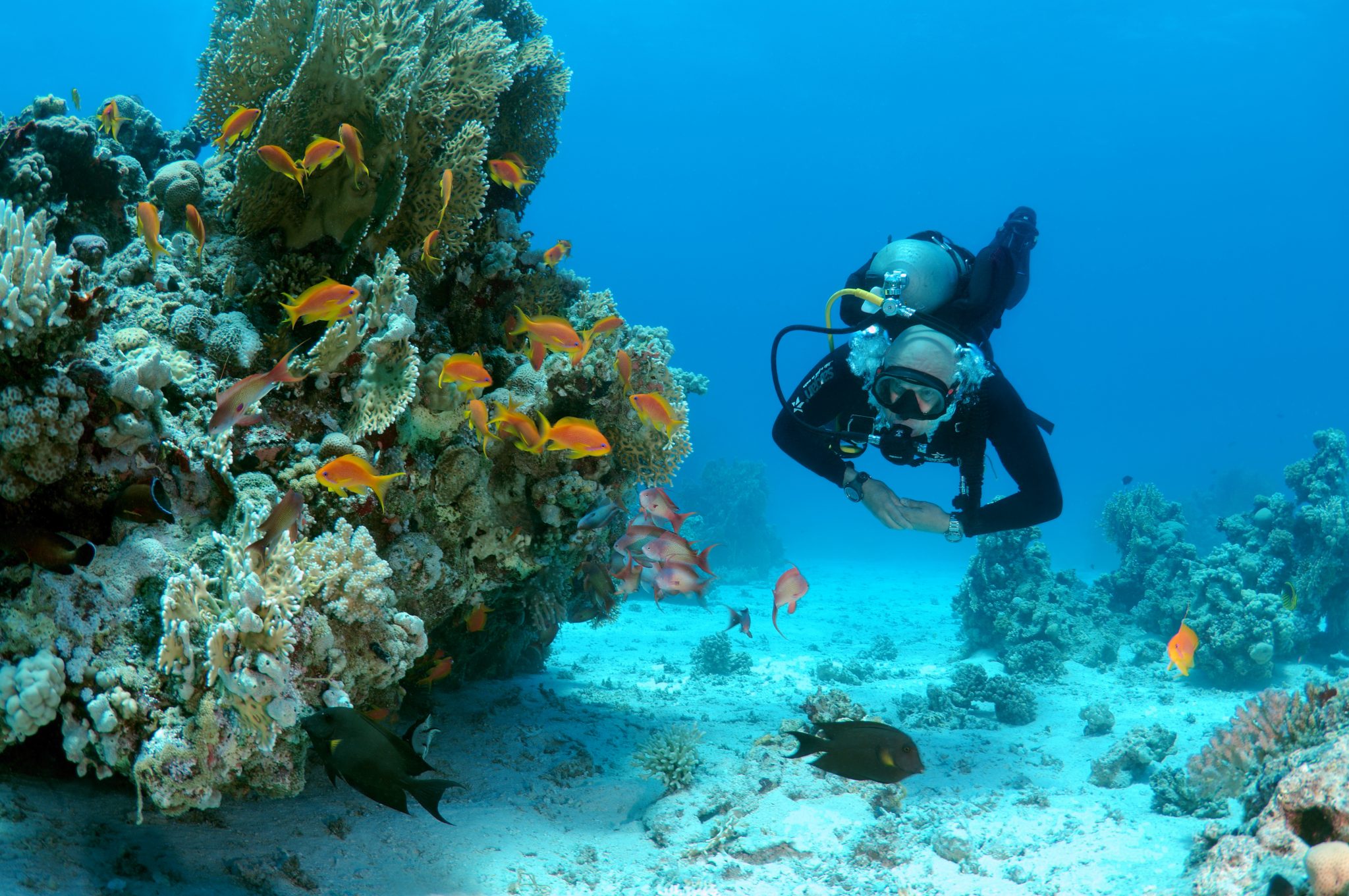
The night dive at Gordon’s Reef was mainly among the stacks of corals surrounded by sand, which was great to explore under the darkness. After some time circling the corals, we came across what we were really hoping to find, and that was an octopus hunting on the reef. We spent the majority of the dive just watching it crawl among the reef, blending into its changing surroundings through changes in colour and skin texture. It’s always so fascinating and captivating to watch these incredibly intelligent animals, in awe of their ability to carry out these physical changes to perfectly blend into the reef. Before we knew it, it was time to head back to the boat to enjoy a well-deserved tasty dinner prepared by the talented chefs onboard.
Check in for the 3rd and final part of this series from Jake tomorrow!
To find out more about the Northern Red Sea reef and wrecks itineraries aboard Ghazala Explorer, or to book, contact Scuba Travel now:
Email: dive@scubatravel.com
Tel: +44 (0)1483 411590
Photos: Jake Davies / Avalon.Red
Marine Life & Conservation
Double Bubble for Basking Sharks

 The Shark Trust is excited to announce that, for two more days only, all donations, large or small, will be doubled in the Big Give Green Match Fund!
The Shark Trust is excited to announce that, for two more days only, all donations, large or small, will be doubled in the Big Give Green Match Fund!
Donate to Basking in Nature: Sighting Giants
The Shark Trust is hoping to raise £10k which will be doubled to £20k. This will go towards Basking in Nature: Sighting Giants. And they need YOUR help to reach they’re goal.
The Shark Trust’s citizen science project is to monitor and assess basking sharks through sightings; encouraging data collection, community engagement, and promoting nature accessibility. This initiative aims to enhance health and wellbeing by fostering a deeper connection with British Sharks.
Campaign Aims
- Increase citizen science reporting of Basking Sharks and other shark sightings to help inform shark and ray conservation.
- Provide educational talks about the diverse range of sharks and rays in British waters and accessible identification guides!
- Create engaging and fun information panels on how to ID the amazing sharks and rays we have on our doorstep! These can be used on coastal paths around the Southwest. With activities and information on how you can make a difference for sharks and rays!
- Promote mental wellbeing through increasing time in nature and discovering the wonders beneath the waves!
Donate, and double your impact. Click Here
-
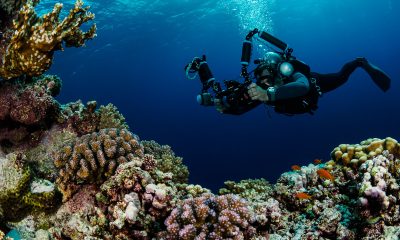
 News3 months ago
News3 months agoHone your underwater photography skills with Alphamarine Photography at Red Sea Diving Safari in March
-
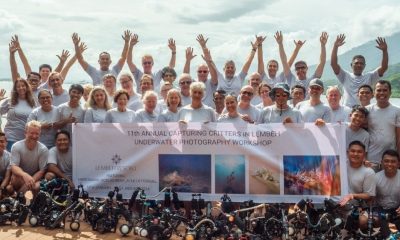
 News3 months ago
News3 months agoCapturing Critters in Lembeh Underwater Photography Workshop 2024: Event Roundup
-

 Marine Life & Conservation Blogs2 months ago
Marine Life & Conservation Blogs2 months agoCreature Feature: Swell Sharks
-

 Blogs2 months ago
Blogs2 months agoMurex Resorts: Passport to Paradise!
-

 Blogs2 months ago
Blogs2 months agoDiver Discovering Whale Skeletons Beneath Ice Judged World’s Best Underwater Photograph
-

 Gear Reviews2 months ago
Gear Reviews2 months agoGear Review: Oceanic+ Dive Housing for iPhone
-

 Marine Life & Conservation2 months ago
Marine Life & Conservation2 months agoSave the Manatee Club launches brand new webcams at Silver Springs State Park, Florida
-

 News3 months ago
News3 months agoWorld’s Best Underwater Photographers Unveil Breathtaking Images at World Shootout 2023



